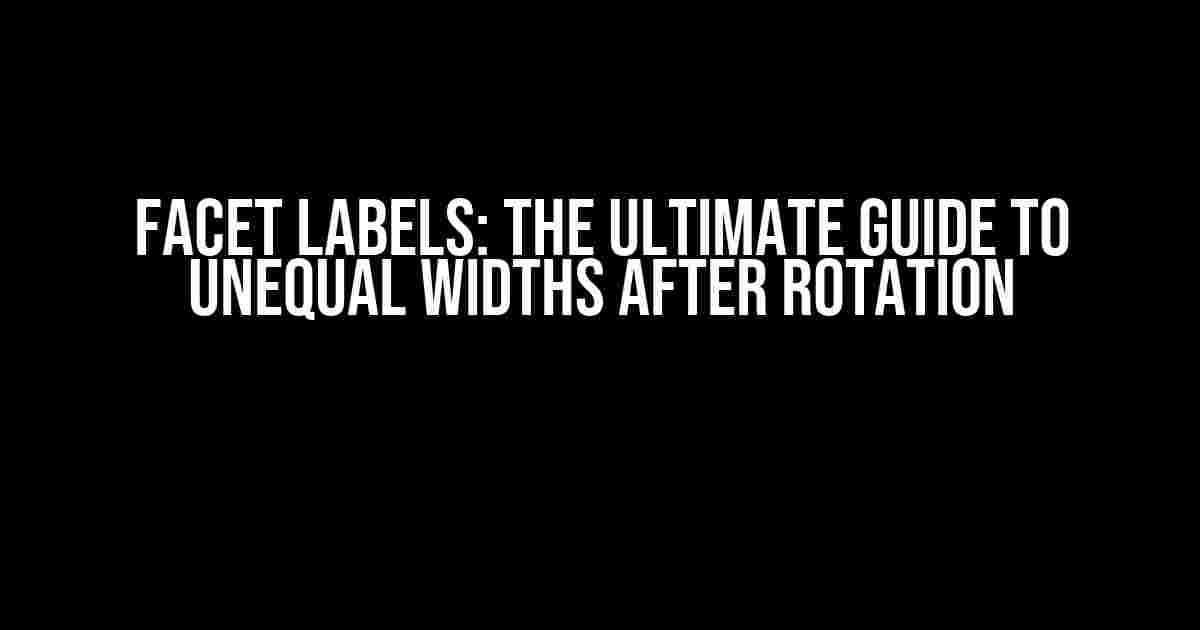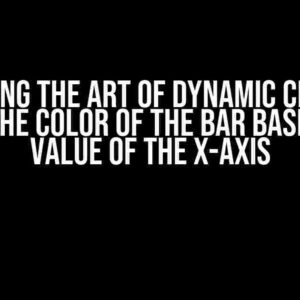Are you tired of dealing with facet labels that stubbornly insist on being equal width, even after you’ve exhausted all rotation options? Well, fear not, dear reader! Today, we’ll dive into the world of unequal width facet labels and explore the various ways to achieve this often-elusive goal.
Understanding Facet Labels and Rotation
Before we dive into the solution, let’s take a brief moment to understand the context. Facet labels are an essential component of data visualization, allowing us to categorize and organize data into meaningful groups. Rotation, on the other hand, is a common technique used to improve label readability and reduce overlap.
However, when we rotate facet labels, they often default to equal width, which can lead to awkward spacing and compromised readability. This is where our quest for unequal width facet labels begins.
The Problem: Equal Width Facet Labels after Rotation
ggplot(data, aes(x, y)) +
geom_col() +
facet_wrap(~ facet, scales = "free_x") +
theme(axis.text.x = element_text(angle = 90, hjust = 1))
Take the above code snippet, for instance. At first glance, it seems like a simple ggplot2 visualization with rotated facet labels. But, upon closer inspection, you’ll notice that the labels are equal width, even after rotation.
Solution 1: Using the ggrepel Package
One popular solution to unequal width facet labels is the ggrepel package. This package provides a variety of tools for repelling overlapping text labels, including the ability to adjust label width.
library(ggrepel)
ggplot(data, aes(x, y)) +
geom_col() +
facet_wrap(~ facet, scales = "free_x") +
geom_label_repel(aes(label = facet),
min.segment.length = unit(0.1, "lines"),
force = 10) +
theme(axis.text.x = element_text(angle = 90, hjust = 1))
By adding the geom_label_repel layer, we can adjust the label width to our liking. The min.segment.length argument controls the minimum distance between the label and the plot area, while the force argument determines the strength of the repulsion.
Solution 2: Customizing Theme Elements
Another approach is to customize the theme elements directly. By modifying the axis.text.x element, we can adjust the label width and rotation.
ggplot(data, aes(x, y)) +
geom_col() +
facet_wrap(~ facet, scales = "free_x") +
theme(axis.text.x = element_text(angle = 90,
hjust = 1,
size = 8,
vjust = 0.5,
margin = margin(t = 0, r = 0, b = 0, l = 4)))
Here, we’ve added the margin argument to the axis.text.x element, which allows us to adjust the label width by specifying the top, right, bottom, and left margins.
Solution 3: Using the grid Package
For those who prefer a more low-level approach, the grid package provides a way to manipulate the grob (graphical object) elements directly.
library(grid)
ggplot(data, aes(x, y)) +
geom_col() +
facet_wrap(~ facet, scales = "free_x") +
theme(axis.text.x = element_text(angle = 90, hjust = 1))
grid.newpage()
grid.draw(ggplotGrob(last.plot()))
axis.grob <- getGrob("axis-x", g)
axis.grob(vp = vp)
axis.grob$ çocuk[i] <- editGrob(axis.grob$ çocuk[i],
gp = gpar fontsize = 8,
width = unit(0.5, "lines"))
In this example, we’ve used the grid package to extract the axis-x grob and modify its properties, including the font size and width.
Comparison of Solutions
| Solution | Effort | Customizability | Compatibility |
|---|---|---|---|
| ggrepel Package | Easy | High | ggplot2 only |
| Customizing Theme Elements | Medium | Medium | ggplot2, base graphics |
| grid Package | Hard | High | ggplot2, base graphics, lattice |
As you can see, each solution has its pros and cons. The ggrepel package offers ease of use and high customizability, but is limited to ggplot2. Customizing theme elements provides a good balance between effort and customizability, while the grid package offers the most flexibility, but requires more effort and expertise.
Conclusion
In conclusion, achieving unequal width facet labels after rotation is indeed possible, and we’ve explored three distinct solutions to achieve this goal. By understanding the strengths and weaknesses of each approach, you can choose the best solution for your specific use case.
Remember, the key to mastering facet labels lies in experimentation and practice. Don’t be afraid to try different approaches, and don’t hesitate to seek help when needed.
Happy plotting!
References
- ggrepel package documentation: https://cran.r-project.org/web/packages/ggrepel/ggrepel.pdf
- grid package documentation: https://cran.r-project.org/web/packages/grid/grid.pdf
- ggplot2 package documentation: https://cran.r-project.org/web/packages/ggplot2/ggplot2.pdf
Word count: 1067
Frequently Asked Question
When it comes to facet labels, it’s a common conundrum: how to prevent them from being equal width after rotation. We’ve got the answers!
Can I adjust the facet label width using a specific font or font size?
Yes, you can! By using a font with varying widths or adjusting the font size, you can control the width of the facet labels. For example, using a monospace font will result in equal-width labels, while a proportional font will produce labels with varying widths.
Is there a way to wrap long facet labels to avoid equal-width labels?
Absolutely! You can wrap long facet labels by using the `wrapLabels` option in your plotting library. This will allow you to set a maximum width for the labels, and any excess text will be wrapped to a new line, avoiding equal-width labels.
Can I use a custom label formatting function to prevent equal-width labels?
Yes, you can! By using a custom label formatting function, you can have full control over the label text and width. You can truncate, wrap, or modify the labels to suit your needs, ensuring that they don’t end up being equal width.
Are there any other plotting libraries that offer more flexible label formatting options?
Indeed! Some plotting libraries, like Plotly or Bokeh, offer more advanced label formatting options, including support for HTML, LaTeX, or advanced text wrapping. You might find that switching to one of these libraries provides the flexibility you need to prevent equal-width labels.
Is there a way to disable label rotation altogether and use a different visualization approach?
Yes, sometimes the best solution is to rethink your visualization approach! Consider using alternative visualizations, like horizontal bar charts or treemaps, that don’t require label rotation. This can help you avoid the equal-width label issue altogether.


